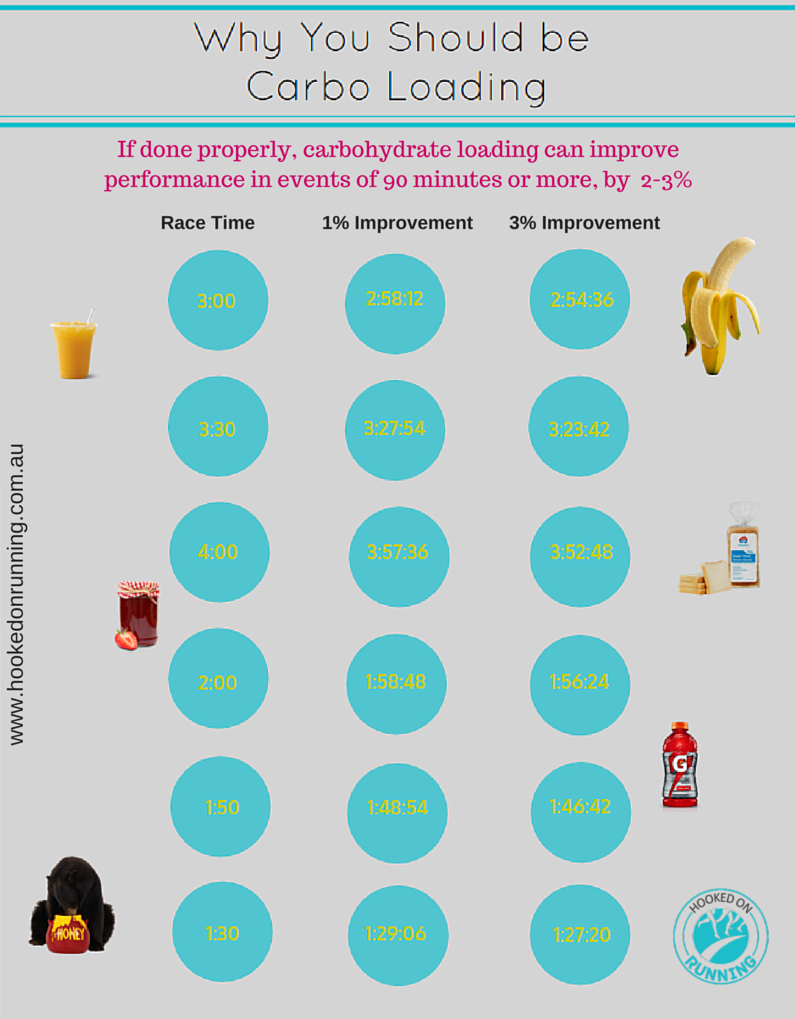
What is Carbohydrate Loading?
Carbohydrate loading (aka carb loading or carbo loading) is a strategy to boost muscle glycogen (carbohydrate) stores. It involves modifications to training and nutrition. It does not mean eat your head off for the few days leading into a race! If done properly, carbohydrate loading can improve performance in endurance events lasting 90 minutes or more, by as much as 2-3%.
That’s massive. Even a 1% improvement could be the difference between you getting under that elusive mark you’ve set yourself.
What Does a 3% Improvement Look Like on the Road?
1% Improvement
- 3 hour marathon becomes 2:58:12
- 3:30 marathon becomes 3:27:54
- 4 hour marathon becomes 3:57:36
- 2 hour half marathon becomes 1:58:48
- 1 hour 50 half marathon becomes 1:48:54
- 90 min half marathon becomes 89:06
3% Improvement
- 3 hour marathon becomes 2:54:36
- 3:30 marathon becomes 3:23:42
- 4 hour marathon becomes 3:52:48
- 2 hour half marathon becomes 1:56:24
- 1 hr 50 half marathon becomes 1:46:42
- 90 min half marathon becomes 87:20
History of Carbohydrate Loading
- Developed in the late 1960’s
- Originally involved 3-4 days of heavy training and low carbohydrate eating (the depletion phase) followed by 3-4 days of rest combined with a high carbohydrate diet (the loading phase)
- 2002 research shows that maximum glycogen stores can be reached with 24 hours of inactivity combined with a high carbohydrate eating regime. There is no need for the depletion phase.
Sometimes the Simplest Method is the Best
Researchers at the University of Western Australia carried out two studies, published in 2002, which showed the simplest and most effective way to “carb load” was to eat 10 grams of high glycaemic index carbohydrate, per kg of body weight in the 24 hour period before endurance exercise. This needs to be coupled with a 24 hour period of inactivity.
Prior to these studies, it was generally agreed that for muscles to achieve maximum glycogen storage, a bout of intense exercise needed to be undertaken to deplete muscle glycogen stores. Knowing that athletes were unlikely to want to complete 3 mins of intense exercise the day before a race, the researchers tested whether the same effect could be achieved without the intense exercise bout. And lucky for us, it can.
Protocol
- In the 24 hour period leading into a race, do no exercise. In reality, this may be difficult, but you should do as little exercise as possible. That means don’t run round after the kids, don’t do the shopping, don’t clean the house. Put your feet up and catch up on a good book or movie.
- For every 1 kg of body weight, consume 10 grams of high glycaemic index carbohydrate. This means you’ll need to stay away from higher fibre foods such as wholegrain bread, and steer away from fatty foods as well. If you’re eating dairy foods, use low fat (which is something I don’t usually advocate just for the record). If you want to eat bread, stick to white bread. Take in sugary drinks – fruit juice without the pulp, or dare I say it, cordial. Honey, jam, low-fat fruit yoghurt. No meat.
You may find you’re carrying a kilo or two into the race. This is the extra glycogen your muscles are holding, which will be used up as the race progresses, so it’s nothing to be concerned about.
References
Eur J Appl Physiol. 2002 Jul;87(3):290-5. Epub 2002 May 28.
Carbohydrate loading in human muscle: an improved 1 day protocol.
Bussau VA, Farichild TJ, Rao A, Steele P, Fournier PA
Med Sci Sports Exerc. 2002 Jun;34(6):980-6.
Rapid carbohydrate loading after a short bout of near maximal-intensity exercise.
Fairchild TJ, Fletcher S, Steele P, Goodman C, Dawson B, Fournier PA


